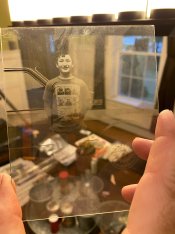Yesterday I was hanging some 120 size film to dry in our sauna and I noticed strange effect. The sauna was really dim and light was coming in from small window. The hazy light lit the negative so that I could see the positive image! It was a bit amazing effect.
I thought this is so cool and I need to make an apparat to reproduce this everywhere. So I did. I milled a box, covered the inside so that it doesn't reflect and prototyped the lightning.
Here is the result:

Here is s a shot of the box without inside light so you can see that it is really a negative

Is this an old idea or has someone made such displays?
Do you have any ideas how to "intensify" the image so that less light would be needed (deeper blacks)? I guess overdevelopment increases fog?
I thought this is so cool and I need to make an apparat to reproduce this everywhere. So I did. I milled a box, covered the inside so that it doesn't reflect and prototyped the lightning.
Here is the result:
Here is s a shot of the box without inside light so you can see that it is really a negative

Is this an old idea or has someone made such displays?
Do you have any ideas how to "intensify" the image so that less light would be needed (deeper blacks)? I guess overdevelopment increases fog?





